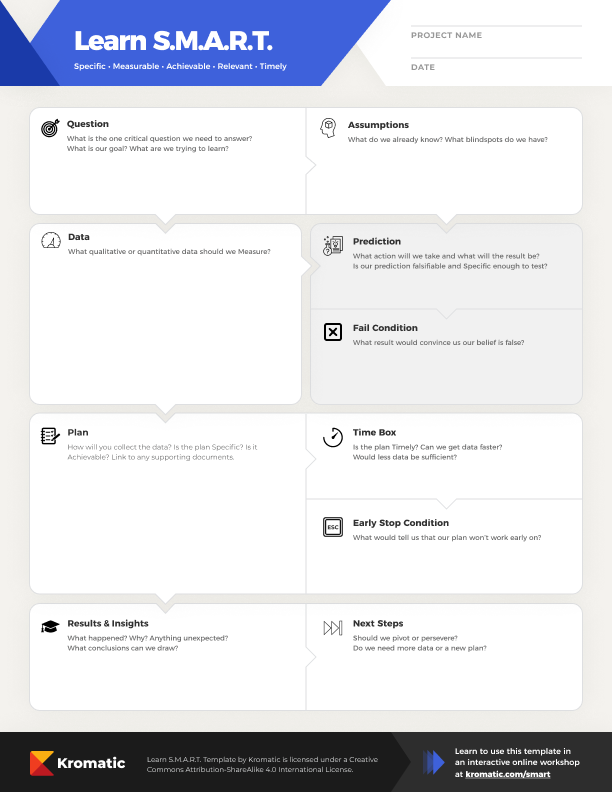Learn S.M.A.R.T. Template
A detailed experiment template to help you design and document S.M.A.R.T. experiments and research. (S.M.A.R.T. = Smart, Measurable, Achievable, Relevant, Timely.)

When to Use It
Use this template when you need to:
- You need to make a business decision
- The situation or business model is new or there is no single correct answer
- More information would help you make the decision
- You have a limited time to collect new information
Who Should Use It
Best for experienced practitioners who want to retain detailed documentation of their business experiments. If you're a beginner, consider using the Learn S.I.M.P.L.E. experiment template to get your experiments started.
How It Works
Learn S.M.A.R.T. Template
Read through the experiment template from top to bottom and fill out sections as you go.
For each section, use the prompts to generate a number of ideas before deciding on what to fill out.
Question:
Identify what you need to know. Based on the business decision you need to make, what information would help you make the right decision? Choose only one question to focus on.
Assumptions:
Identify what you already know and what blind spots you have.
Data:
Identify the data that would help you answer that single question. There may be a number of different data sources that are available to answer any given question. You may select several data sources.
Prediction:
Identify what action will be taken and what the result will be. Check if your prediction is falsifiable and specific enough to test
Fail Condition:
Identify what result would convince you that your belief is false.
Plan:
Create individual plans to gather the data you selected. What is the simplest way you can gather each individual piece of data? You do not need as much data as you think! Think of plans that you can do in one week. Then select the simplest, fastest plan than will get you the most data. Eliminate any other ideas and remove data you don’t plan to collect.
Time Box:
Determine if the plan is timely and if you can get data faster.
Early Stop Condition:
Determine what would tell you that your plan won't work early on.
Results:
Don’t fill this out yet! Go and run the experiment or research project by executing on your plan, then record the results after. If they don’t all fit on the page, just add a summary and write down where someone could find the complete results.
Next Steps:
Should you pivot or persevere?
Authors and Contributors

Tristan Kromer
Tristan Kromer works with innovation teams and leaders to create amazing products and build startup ecosystems. He has worked with companies from early stage startups with zero revenue to enterprise companies with >$1B USD revenue (Unilever, Swisscom, Salesforce, Fujitsu, LinkedIn).
Have a Question?
Ask us anything.
Kromatic offers more than 300 innovation resources including frameworks, templates, articles, videos, and workshops to accelerate your project.
